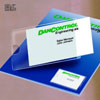The model R710 color reflection densitometer utilizes the most advanced technology to ensure great accuracy, inter-instrument, and repeatablity. This instrument combines functionality and simple user interface in a small, lightweight design.
The model R710 measures: Density, and Density Difference.
Features:
- Simple user interface with self-guiding prompts;
- Menu-driven display guides the operator through calibration, set-up, and all measurement functions;
- Extremely reliable and requiring little or no maintenance;
- Multiple language user interface supported (English, Spanish, Portuguese, French, Italian, German, and Japanese);
- Easy and low cost maintenance;
- Manufactured in Japan under ISO 9001 certification;
- Upgradeable to the model R720 or model R730.
Accessories:
- Operations Manual
- Calibration Standard
- Multi-voltage input AC Adapter
- Carrying Case
- Serial Interface Cable (Optional)
- Cable Harness (Optional)
For a nominal fee, you could upgrade your R710 to the model R720 or R730. E-mail for more information.
Features / Measurements
DENSITY
Densitometers do not actually measure ink thickness, but rather measure reflected light. A logarithmic equation is used to calculate density from the light absorbed by the surface. To calculate the absorbed light on a surface, the difference between the light reflected back from the surface and the light supplied by the densitometer is used.
Densitometers calculate density by using this equation:
Density Equation = log10 1/R, where R= % Reflection
| % Reflectance |
DENSITY |
| 100% |
0.0D |
| 10% |
1.0D |
| 1% |
2.0D |
| 0.1% |
3.0D |
| 0.01% |
4.0D |
| 0.001% |
5.0D |
| 0.0001% |
6.0D |
As you can see the equation is logarithmic, which converts into the values shown on Table 1. To explain the Table further, it can be understood as a density of 1.00 is reflecting 10% of the light.
Your density reading is a guide to keeping your ink level monitored and consistent. In doing this throughout your press run you can detect any changes that could alter your print quality and allow to provide quality control over maximizing the use of your inks.
Below, are some typical wet ink densities, to follow as guidelines.
| |
BLACK |
CYAN |
MAGENTA |
YELLOW |
| SHEET-FED, OFFSET |
1.70 D |
1.40 D |
1.50 D |
1.10 D |
| WEB-OFFSET, Magazine |
1.55 D |
1.30 D |
1.40 D |
1.00 D |
| NON-HEATSET WEB, Newspaper |
1.05 D |
0.90 D |
0.90 D |
0.85 D |
Table 2: GATF-Measurements were made using a Status-T densitometer, and the density of the paper was included in the measurement.
Most densitometers give you the option to include or not include the density of your substrate into your reading. If you chose to include the measured density of the substrate or base along with the ink sample, this is known as Absolute Density. If you subtract the density of the substrate from the density of the ink sample, this is known as Relative Density.
DENSITY DIFFERENCE
Density Difference allows you to establish a reference density and compare this to a sample density. Say you choose your reference color and it reads Yellow 1.05D. Now, take a reading of your sample color- say it reads Yellow 1.02D. The densitometer will subtract your reference color from your sample to show the difference between the two densities. In this example, your Sample yellow deviates (-0.03D) from your Reference yellow.
Many times the naked eye is not enough. Two colors may appear to be identical when in reality they are not. You may notice changes in your image, yet you feel your density value has remained constant. The density difference function helps aid in these situations.
Product Specifications
Measuring Geometry: 0°/45° (ANSI PH2.17, ISO 5/4, DIN 16536)
Filter Response Status: Status T, Status E, Status A
Repeatability: ±0.01D
Measuring Range: Density 0.00D - 2.50D
Accuracy: ±0.02D
Light Source: Halogen Lamp, Approx. 2856°K
Aperture Diameter: 3.0mm (1.7mm optional)
Detector: GaAsP Photodiode
Display: 128 x 64 Dot Graphic LCD
Power Supply: Ni-Cad (4.8V), 800mAh
Recharge Time: Approximately 1.5 hours
Measurements per Charge: Approximately 4,000 (Internal Testing)
Warm Up Time: None
Measuring Time: Approximately 1 second
Operating Temp. Range: 41°F ~ 104°F (5°C ~ 40°C)
Polarization Filter: (Optional)
Security User Code: (Optional)
Dimensions: 2 3/4" W x 2" H x 8 1/4" L (72mm x 50mm x 210mm)
Weight: 1.2 lbs. (with batteries) (530 g)
Computer Output: Configurable RS-232C Serial Interface
Comes standard with a US 2-Pin flat plug.
Also available with a Euro 2-pin round plug or a British 3-pin plug.
E-mail for information and a quote.
If ordering a NiCd Battery Pack please include the below information to verify correct battery is being ordered.
- E-mail serial number of existing densitometer, or
- E-mail part number from existing battery pack, or if it shows R1, R2, or R3, or
- E-mail a picture of existing battery connector
- Models: EQP-R710-TNXU, EQP-R710-TSXU, EQP-R710-TNPU, EQP-R710-ENXU, EQP-R710-ESXU, EQP-R710-ENPU, EQP-BATT-005, EQP-BATT-003 & EQP-BATT-007
















